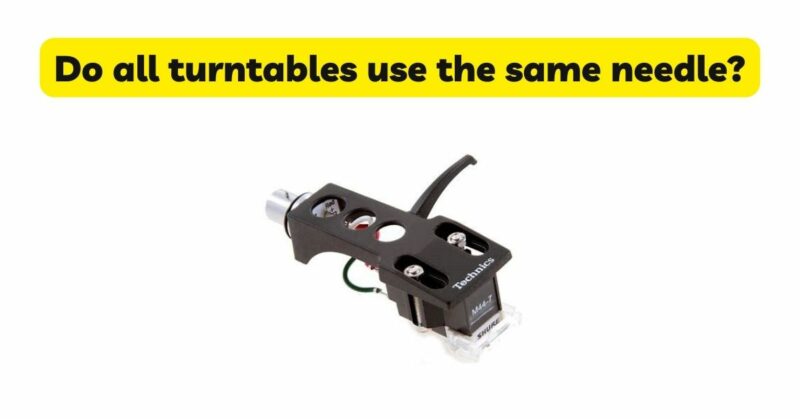Turntables, the heart of vinyl playback, rely on a crucial component known as the needle or stylus. However, the assumption that all turntables use the same needle is far from accurate. In this article, we will delve into the diverse world of turntable needles, uncovering the different types, designs, and compatibility factors that make them unique to each turntable model.
- The Needle’s Role in Vinyl Playback: The needle, or stylus, is the component of a turntable that physically makes contact with the grooves of a vinyl record. Its primary function is to track the intricate modulations within the grooves and convert them into electrical signals that can be amplified and reproduced as sound. The quality and design of the needle play a crucial role in determining the fidelity and accuracy of the audio playback.
- Different Needle Types: Turntable needles come in various types, each designed for specific purposes and record formats. The most common types include:
a. Standard Elliptical Needle: This is the most prevalent type of needle, featuring an elliptical-shaped diamond tip. It provides a good balance between sound quality and record wear.
b. Conical Needle: Conical needles have a rounded tip and are often found on entry-level or vintage turntables. While they are less precise than elliptical or other advanced designs, they are still capable of reproducing sound adequately.
c. Microline and Line Contact Needles: These advanced needle designs feature finer, tapered profiles. They excel at tracking high-frequency information and extracting fine details from the record grooves, resulting in improved clarity and resolution.
d. Shibata and Van den Hul Needles: These premium needle designs further refine the microline concept, offering even greater accuracy and fidelity. They are commonly found on high-end audiophile turntables.
- Compatibility with Turntable Models: Not all turntable needles are interchangeable between different models and brands. Each turntable manufacturer designs their own cartridges and needles to match their specific tonearm geometry, tracking force requirements, and electrical characteristics. Therefore, it is essential to ensure that the needle is compatible with the particular turntable model to achieve optimal performance.
- Mounting Types: Turntable needles also come in different mounting types, which determine how they attach to the tonearm. The most common mounting types are:
a. Standard Mount: This type of needle has a threaded shaft that screws into the tonearm’s headshell. It is prevalent on most consumer-grade turntables.
b. P-Mount (T4P) Mount: P-Mount needles have a plug-and-play design, with a standard cartridge body and a fixed vertical tracking angle. They are commonly found on entry-level turntables and are easily interchangeable.
c. Half-Inch Mount: This mounting type features a half-inch mount distance between the two screw holes on the headshell. It is commonly used on higher-end turntables and offers greater flexibility for cartridge and needle upgrades.
- Upgrading Needles and Cartridges: Many turntables allow for needle and cartridge upgrades, providing an opportunity to improve sound quality or cater to personal preferences. However, it is crucial to ensure compatibility between the turntable’s tonearm and the new needle or cartridge. Upgrading to a higher-quality needle or cartridge can often result in improved detail retrieval, enhanced frequency response, and overall better sound reproduction.
- Tracking Force and Alignment: The proper setup of the turntable needle is vital to ensure optimal performance. The tracking force, or the downward pressure applied by the needle on the record, needs to be correctly adjusted. Different needles have specific tracking force requirements, which should be followed to prevent excessive wear or damage to the records. Additionally, proper alignment of the needle within the groove is crucial to minimize distortion and maximize fidelity.
- Specialized Needles for 78 RPM Records: 78 RPM records require specific needles due to their wider grooves and higher playback speed. These needles are typically wider and have a more robust construction to handle the demands of 78 RPM playback. They are not compatible with standard LP records, highlighting the need for specialized equipment or interchangeable stylus options for versatile playback.
- Maintenance and Replacement: Turntable needles, like any other component, require maintenance and periodic replacement. The needle’s diamond tip gradually wears down over time, resulting in degraded sound quality and increased record wear. Regular cleaning and proper care can extend the lifespan of the needle, but eventually, it will need to be replaced to maintain optimal performance.
- Customization and Audiophile Options: For enthusiasts seeking the ultimate in sound quality and customization, there are aftermarket and audiophile-grade needles available. These options often offer superior materials, advanced designs, and meticulous craftsmanship. Customized needles can cater to specific listening preferences and provide an enhanced listening experience for discerning audiophiles.
- The Importance of Needle Selection: Choosing the right needle for a turntable is a critical decision that affects the overall sound quality and longevity of the records. Factors such as budget, desired sound characteristics, and compatibility with the turntable model should be considered when selecting a needle. Consulting with turntable manufacturers, audio experts, or reputable retailers can help in making an informed decision.
Conclusion: Contrary to the assumption that all turntables use the same needle, the world of turntable needles is diverse and intricate. Different needle types, compatibility factors, mounting types, and customization options make each needle unique to specific turntable models and personal preferences. Understanding these characteristics and considerations enables enthusiasts to make informed choices when selecting and upgrading needles, ensuring optimal sound quality and an enhanced vinyl listening experience.


